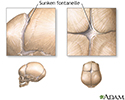Fontanelles - sunken
Sunken fontanelles; Soft spot - sunkenSunken fontanelles are an obvious curving in of the "soft spot" in an infant's head.
-
Considerations
The skull is made up of many bones. There are 8 bones in the skull itself and 14 bones in the face area. They join together to form a solid, bony cavity that protects and supports the brain. The areas where the bones join together are called the sutures.
The bones are not joined together firmly at birth. This allows the head to change shape to help it pass through the birth canal. The sutures gradually gain minerals and harden, firmly joining the skull bones together. This process is called ossification.
In an infant, the space where 2 sutures join forms a membrane-covered "soft spot" called a fontanelle (fontanel). The fontanelles allow the brain and skull to grow during an infant's first year.
There are normally several fontanelles on a newborn's skull. They are located mainly at the top, back, and sides of the head. Like the sutures, fontanelles harden over time and become closed, solid, bony areas.
- The fontanelle in the back of the head (posterior fontanelle) most often closes by the time an infant is 1 or 2 months old.
- The fontanelle at the top of the head (anterior fontanelle) most often closes within 7 to 19 months.
The fontanelles should feel firm and should curve inward slightly to the touch. A noticeably sunken fontanelle is a sign that the infant does not have enough fluid in their body.
##RemoveMe##
-
Causes
Reasons a child may have sunken fontanelles include:
- Dehydration (not enough fluid in the body)
- Malnutrition
##RemoveMe##
-
When to Contact a Medical Professional
A sunken fontanelle can be a medical emergency. A health care provider should check the infant right away.
##RemoveMe##
-
What to Expect at Your Office Visit
The provider will perform a physical exam and ask questions about the child's symptoms and medical history, such as:
- When did you first notice that the fontanelle looked sunken?
- How severe is it? How would you describe it?
- Which "soft spots" are affected?
- What other symptoms are present?
- Has the baby been ill, especially with vomiting, diarrhea, or excessive sweating?
- Is the skin turgor poor?
- Is the baby thirsty?
- Is the baby alert?
- Are the baby's eyes dry?
- Is the baby's mouth moist?
Tests may include:
- Blood chemistries
- CBC
- Urinalysis
- Tests to check the baby's nutritional status
You might be referred to a place that can provide intravenous (IV) fluids if the sunken fontanelle is caused by dehydration.
##RemoveMe##
References
Carlo WA. The newborn infant. In: Kliegman RM, Stanton BF, St. Geme JW, Schor NF, eds. Nelson Textbook of Pediatrics. 20th ed. Philadelphia, PA: Elsevier; 2016:chap 94.
McIntosh M, Wylie T. Emergencies in infants and toddlers. In: Adams JG, ed. Emergency Medicine. 2nd ed. Philadelphia, PA: Elsevier Saunders; 2013:chap 16.





